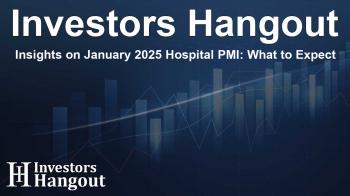Insights on January 2025 Hospital PMI: What to Expect

Latest Developments in Hospital PMI for January 2025
Economic activity within the hospital subsector exhibited growth this January, successfully marking the 17th consecutive month of expansion. This upturn follows a brief contraction period experienced twice in the preceding four months, notable given the 35 consecutive months of growth prior to this dip. Insights gathered from hospital supply executives reveal optimism tempered by concern.
Key Indicators and Economic Activity
Report findings from the Institute for Supply Management reveal that the Hospital PMI registered at 53.5 percent for January, a modest decrease of 2.8 percentage points from December's figure of 56.3 percent. This indicates the continuation of growth, albeit at a slower pace. The Business Activity Index comfortably remained in expansion territory for the third successive month, illustrating resilience and steady operational dynamics. Similarly, both the New Orders Index and Employment Index indicated ongoing expansion, reflecting an influx in orders and sustained growth in workforce engagement.
Delivery Performance and Challenges
Pondering on the delivery aspect, the Supplier Deliveries Index has remained in expansion for 17 months, yet signifies slower delivery performance. Furthermore, the Case Mix Index did show a slight regression with a score of 53 percent, down 0.5 percentage points from December. The Days Payable Outstanding Index reverted to contraction territory, suggesting heightened scrutiny over payables.
Concerns from the Industry
Nancy LeMaster, Chair of the Hospital Business Survey Committee, addressed the report detailing prevalent concerns from panelists regarding the impact of tariffs on supply pricing. A significant sentiment has emerged around the belief that certain suppliers might exploit tariff situations and unjustifiably hike prices. Additionally, respiratory cases began to play a notable role in influencing patient volume. A lingering aftermath of natural disasters, specifically a shortage of IV fluids caused by past hurricanes, has forced some facilities to postpone elective procedures. This trend emphasizes the need for preparedness amidst ongoing challenges seen within healthcare environments.
Employment Growth and Future Projections
Job growth remains positive as the healthcare sector continues to recruit effectively to match the increased demand created by a rise in acute conditions among patients. Hospitals are prioritized for increased inventory as a buffer against product shortages while gearing up for the peak season of respiratory illnesses. These strategic moves display how hospitals across the nation aim to maintain service levels while navigating the ongoing challenges they face.
Understanding Hospital PMI Index Calculations
The Hospital PMI serves as a composite index reflective of various factors within the healthcare sector, notably Business Activity, New Orders, Employment, and Supplier Deliveries. With a PMI reading above 50 percent marking expansion, stakeholders can gain insights into broader economic conditions within the hospital sub-sector. Each indicator plays a crucial role in projecting future operational conditions as healthcare providers strive to adapt and thrive in a fluctuating landscape.
Data Collection Processes and Transparency
The data for this comprehensive report derives from a methodical survey undertaken by the Institute for Supply Management, capturing perspectives from hospital supply executives across the nation. By focusing solely on operational data for current month transactions, ISM ensures that analysis reflects the most relevant market trends. This diligent approach to data collection enhances the accuracy and reliability of the index, fostering informed decision-making backed by empirical evidence.
Upcoming Releases and Future Insights
The next report on Hospital PMI, showcasing February 2025 data, is set to be unveiled early next month. As the supply chain continues the resilience mantra amid ongoing challenges, all eyes remain keen on interpreting how economic indicators transform in response to fluctuating market conditions, including ongoing market pressures and emerging trends.
Frequently Asked Questions
What does a PMI reading above 50% indicate?
A PMI reading above 50% indicates general expansion within the sector, signaling positive economic conditions and growth opportunities.
How often is the Hospital PMI report released?
The Hospital PMI report is released monthly, providing timely updates on industry trends and economic conditions affecting the hospital sector.
What factors are included in the Hospital PMI index?
The Hospital PMI index includes key indicators such as Business Activity, New Orders, Employment, and Supplier Deliveries which capture operational dynamics.
What challenges are highlighted in the latest report?
Challenges include tariff impacts on supply prices, the repercussions of environmental events on inventory, and the ongoing demand for acute care services.
Who oversees the Hospital PMI report?
The report is overseen by the Institute for Supply Management, ensuring rigorous data collection and analysis relevant to the healthcare supply chain management field.
About The Author
Contact Dominic Sanders privately here. Or send an email with ATTN: Dominic Sanders as the subject to contact@investorshangout.com.
About Investors Hangout
Investors Hangout is a leading online stock forum for financial discussion and learning, offering a wide range of free tools and resources. It draws in traders of all levels, who exchange market knowledge, investigate trading tactics, and keep an eye on industry developments in real time. Featuring financial articles, stock message boards, quotes, charts, company profiles, and live news updates. Through cooperative learning and a wealth of informational resources, it helps users from novices creating their first portfolios to experts honing their techniques. Join Investors Hangout today: https://investorshangout.com/
The content of this article is based on factual, publicly available information and does not represent legal, financial, or investment advice. Investors Hangout does not offer financial advice, and the author is not a licensed financial advisor. Consult a qualified advisor before making any financial or investment decisions based on this article. This article should not be considered advice to purchase, sell, or hold any securities or other investments. If any of the material provided here is inaccurate, please contact us for corrections.

